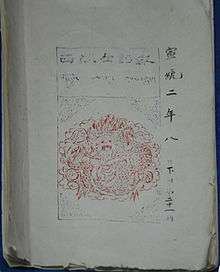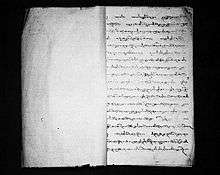Tibet Vernacular Paper
The Tibet Vernacular Paper (simplified Chinese: 西藏白话报; traditional Chinese: 西藏白話報; pinyin: Xīzàng báihuà bào, Tibetan: ནུབ་བོད་ཀྱི་ཕལ་སྐད་ཚགས་པར, Wylie: nub bod kyi phal skad tshags par ),[1] also translated as The Tibetan Vernacular Paper, is the first newspaper to have been established in Tibet. Written in both Tibetan (藏文) and vernacular Chinese (Baihua 白话), it was founded in April 1909 by amban Lian Yu, and his deputy Zhang Yintang, in the final years of the Qing Dynasty. The first issue was lithographically printed, with a print-run fewer than 100 copies a day.[2][3] It was disestablished in 1911.[4] The mission of the newspaper was mainly educational,[4] but also propagandistic.[4][5]Nothing is known about how the paper was received by Tibetans.[6]


Goals
Lian Yu and Zhang Yintang felt that publishing a newspaper in the vernacular language would advance their administrative reforms far more than just making speeches to restricted audiences. They took the Sichuan Yun Bao and other government-funded newspapersd as its models.[7] As few Tibetans could read Chinese and few Chinese could read Tibetan at the time, they plumped for a bilingual newspaper. According to Bai Runsheng, the newspaper was warmly welcomed by the Tibetan people.[8]
Printing, circulation and frequency
The Tibet Vernacular Paper was first printed lithographically (at the rate of fewer than 100 copies a day) on a stone printing machine brought to Tibet by Zhang Yintang.[9] In order to achieve larger print runs, printing machines were later bought in India and brought to Tibet.[10] The newspaper appeared once every ten days, with 300 to 400 copies per issue.[11] It stopped appearing in 1911.[4]
Announcing the arrival of Zhao Erfeng army
Tibetan historian K. Dhondup wrote that one of the first issue of the newspaper was published while the 13th Dalai Lama came back to Lhasa after his first exile, just before his second exile. The paper announced in August 1909 the arrival of Chao Erh-feng army: "Don't be afraid of Amban Chao and his soldiers. They are not intended to do harm to Tibetans, but to other people. If you consider, you will remember how you felt ashamed when the foreign soldiers arrived in Lhasa and oppressed you with much tyranny. We must all be strengthen ourselves on this account, otherwise our religion will be destroyed in 100 or perhaps 1,000 years."[12] On 3 January 1910, the Chinese army entered in Lhasa, shooting at random in the city, resulting in a number of wounded and killed policemen and people.[13]
See also
- (in French) Bai Runsheng, Abrégé de l’histoire de (la) presse chinoise, Éditions de Chine Nouvelle, 1998
- The Tibet Mirror
References
- Fabienne Jagou, Les traductions tibétaines des discours politiques chinois de Sun Yat-sen sur les « Trois principes du peuple » en tant qu’exemples de traductions modernes d’un texte politique, in Édition, Éditions: L'écrit Au Tibet, Évolution et Devenir, Volume 3 de Collectanea Himalayica, Anne Chayet, Éditeur Indus, 2010, ISBN 9783940659026, p. 169
- Protection and Development of Tibetan Culture (White Paper), China Daily, 25-09-2008, p. 7: Old Tibet had only one lithographically printed newspaper in the Tibetan language in the last years of the Qing Dynasty (1644-1911), titled The Tibet Vernacular Newspaper, and its print-run was fewer than 100 copies a day.
- Thubten Samphel, Virtual Tibet: The Media, in Exile as challenge: the Tibetan diaspora (Dagmar Bernstorff, Hubertus von Welck eds.), Orient Blackswan, 2003, 488 pages, especially pp. 171-172 ISBN 978-81-250-2555-9: Tibet's first newspaper, Vernacular Paper, was started by the Manchu amban, Lian Yu, and his deputy, Zhang Yintong in April 1909. The newspaper was bilingual, in Tibetan and Chinese.
- Amy Holmes-Tagchungdarpa, Representations of Religion in The Tibet Mirror, in History and Material Culture in Asian Religions: Text, Image, Object, eds. Benjamin Fleming, Richard Mann, p. 77.
- Françoise Robin, Le vers libre au Tibet : une forme littéraire de l'intime au service d'un projet collectif, dans D'un Orient l'autre, actes des 3es journées de l'Orient, Bordeaux, 2-4 octobre 2002 (sous la direction de Jean-Louis Bacqué-Grammont, A. Pino, S. Khoury), Peeters Publishers, 2005, 606 p., pp. 573-601, en part. p. 583, note 31 : "un journal de propagande publié à Lhas[s]a par les autorités mandchoues à la fin de 1909 (Dhondup 1976: 33)".
- Anna Sawerthal (2011). The Melong: An Example of the Formation of a Tibetan Language Press (PDF) (MA thesis). University of Vienna, Austria. p. 55. Archived from the original (PDF) on 4 March 2016. Retrieved 28 September 2017.
- Bai Runsheng, The earliest Tibetan newspaper in Tibet Archived 2015-11-17 at the Wayback Machine, China Tibet Information Center, 2005-07-01: "But in Tibet the old customs had taken such a deep root that it was difficult to get effective results through administrative reformation. So Lian Yu and Zhang Yintang thought that to publish a newspaper in the vernacular language would get better results than to make speeches in narrow spheres. This was why they founded the "Vernacular Paper in Tibet." Aiming at educating people in patriotism and intelligence. The paper took "Xun Bao", a newspaper of Sichuan, and other government-funded newspaper of other provinces as its models, It was the first modern newspaper in Tibetan areas."
- Bai Runsheng, op. cit.: "At that time few Tibetans knew Chinese, and the same was true for the Chinese. So the newspaper was published in Tibetan and Chinese. The bilingual newspaper was warmly welcomed by the Tibetan people. It was said that many readers came to buy the newspaper."
- Xinhua, Protection and Development of Tibetan Culture (White Paper), China Daily, 25-09-2008, p. 7:"Old Tibet had only one lithographically printed newspaper in the Tibetan language in the last years of the Qing Dynasty (1644-1911), titled The Tibet Vernacular Newspaper, and its print-run was fewer than 100 copies a day."
- Bai Runsheng, op. cit.: "The first issue of the paper was printed with the stone printing machine brought to Tibet by the deputy amban Zhang Yintang. In order to run the newspaper for long, Lian Yu sent men to Calcutta to buy printing machines."
- Bai Rusheng, op. cit.: "The "Vernacular Paper in Tiber" was a publication appearing once every ten days, with 300 to 400 copies per issue."
- Elliot Sperling, "The Chinese Venture into K'am, 1904–11 and the Role of Chao Erhfeng", in The History of Tibet: The modern period:1895-1959, the encounter with modernity, ed Alex McKay
- K. Dhondup, The water-bird and other years: a history of the Thirteenth Dalai Lama and after, 1986, Rangwang Publishers, p. 33 "But his stay in Lhasa was to be short. A second exile was in front of him. As a prelude to this, there appeared in Lhasa for the first time a newspaper published by the Chinese in Tibetan. One of the issues said: […] On 3rd January 1910, the advance unit of the Chinese army reached the banks of Kyichu river where the Manchu Amban waiting for them. That very afternoon they burst into Lhasa. They randomly fired in the city, wounding and killing a number of policemen and people"